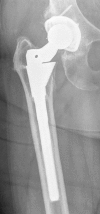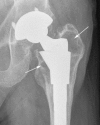Modular femoral sleeve and stem implant provides long-term total hip survivorship
- PMID: 20809170
- PMCID: PMC3018229
- DOI: 10.1007/s11999-010-1524-0
Modular femoral sleeve and stem implant provides long-term total hip survivorship
Abstract
Background: A femoral implant with a modular sleeve and stem has been designed to allow independent and complete metaphyseal-diaphyseal fit and fill as well as independent rotation to accommodate anteversion at the time of THA.
Questions/purposes: In a prospective study we asked whether such a modular femoral sleeve and stem implant used during THA could provide (1) high long-term survivorship; (2) radiographically stable implants without radiolucencies, stress shielding, or osteolysis; and (3) high clinical scores in patients 15 to 20 years after a primary THA.
Patients and methods: We prospectively evaluated 31 hips that underwent a primary THA using a modular femoral component for clinical outcome (Harris hip score) and radiographic outcome (implant stability, femoral loosening, osteolysis and stress shielding) at a minimum followup of 15 years (mean, 17 years; range, 15-20.2 years).
Results: There were no femoral revisions for aseptic loosening; all hips had radiographic evidence of bone ingrowth. Two well-ingrown components were revised for late hematogenous infection. Some degree of proximal femoral disuse atrophy from stress shielding occurred in 23 hips (74%) but was nonprogressive and did not result in any failures or complications. Femoral osteolysis occurred in 18 hips (58%), but we cannot definitively determine whether or not the modular junction contributed to this.
Conclusions: These data suggest this modular femoral stem can provide long-term survivorship with no cases of aseptic loosening at 15 to 20 years after primary THA. However, it may be prudent when using this femoral stem to consider an articulation with an alternative bearing or, if the modularity is not needed to address femoral anteversion and metaphyseal-diaphyseal mismatch, to consider a nonmodular femoral stem.
Level of evidence: Level III, therapeutic study. See Guidelines for Authors for a complete description of levels of evidence.
Figures




Similar articles
-
Long-term results and bone remodeling after THA with a short, metaphyseal-fitting anatomic cementless stem.Clin Orthop Relat Res. 2014 Mar;472(3):943-50. doi: 10.1007/s11999-013-3354-3. Epub 2013 Oct 26. Clin Orthop Relat Res. 2014. PMID: 24163094 Free PMC article.
-
Can a Conical Implant Successfully Address Complex Anatomy in Primary THA? Radiographs and Hip Scores at Early Followup.Clin Orthop Relat Res. 2016 Feb;474(2):459-64. doi: 10.1007/s11999-015-4480-x. Clin Orthop Relat Res. 2016. PMID: 26245165 Free PMC article.
-
High Survivorship With Cementless Stems and Cortical Strut Allografts for Large Femoral Bone Defects in Revision THA.Clin Orthop Relat Res. 2015 Sep;473(9):2990-3000. doi: 10.1007/s11999-015-4358-y. Epub 2015 May 27. Clin Orthop Relat Res. 2015. PMID: 26013152 Free PMC article.
-
Bimodular femoral stems in primary total hip arthroplasty.Expert Rev Med Devices. 2023 Jul-Dec;20(12):1051-1064. doi: 10.1080/17434440.2023.2264177. Epub 2023 Nov 24. Expert Rev Med Devices. 2023. PMID: 37753590 Review.
-
Advancement in total hip implant: a comprehensive review of mechanics and performance parameters across diverse novelties.J Mater Chem B. 2023 Nov 15;11(44):10507-10537. doi: 10.1039/d3tb01469j. J Mater Chem B. 2023. PMID: 37873807 Review.
Cited by
-
Relationship between Stress Shielding and Optimal Femoral Canal Contact Regions for Short, Tapered-Wedge Stem Analyzed by 2D and 3D Systems in Total Hip Arthroplasty.J Clin Med. 2023 Apr 26;12(9):3138. doi: 10.3390/jcm12093138. J Clin Med. 2023. PMID: 37176578 Free PMC article.
-
Modular Stems: Advantages and Current Role in Primary Total Hip Arthroplasty.Hip Pelvis. 2018 Sep;30(3):147-155. doi: 10.5371/hp.2018.30.3.147. Epub 2018 Sep 4. Hip Pelvis. 2018. PMID: 30202748 Free PMC article. Review.
-
[Total hip replacement in developmental dysplasia: anatomical features and technical pitfalls].Orthopade. 2011 Jun;40(6):543-53. doi: 10.1007/s00132-011-1754-1. Orthopade. 2011. PMID: 21562860 German.
-
Modular stem in total hip arthroplasty for patients with trochanter valgus deformity: surgical technique and case series.BMC Musculoskelet Disord. 2020 Feb 24;21(1):124. doi: 10.1186/s12891-020-3145-4. BMC Musculoskelet Disord. 2020. PMID: 32093714 Free PMC article.
-
Stable fixation of short-stem femoral implants in patients 70 years and older.Clin Orthop Relat Res. 2012 Feb;470(2):442-9. doi: 10.1007/s11999-011-2063-z. Clin Orthop Relat Res. 2012. PMID: 21927967 Free PMC article.
References
Publication types
MeSH terms
LinkOut - more resources
Full Text Sources
Medical
Research Materials

